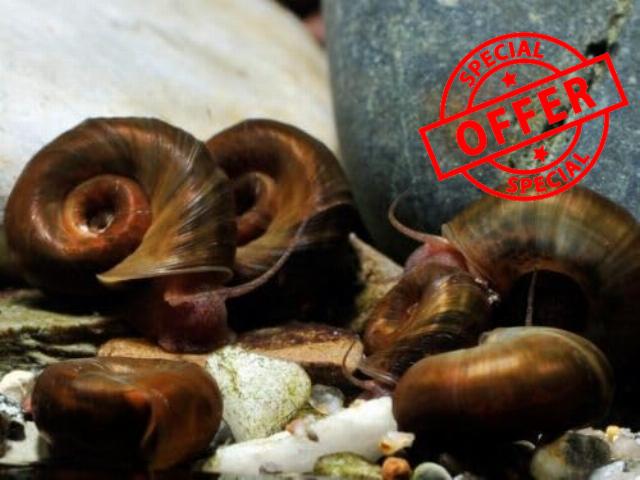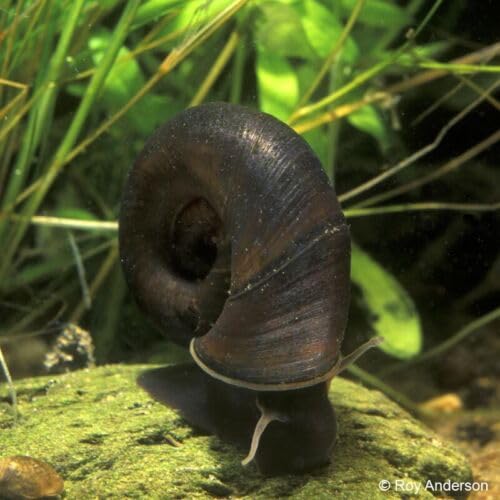Pond Snails X 10 UK Native Ramshorn Snails. Algae

Pond Snails X 10 UK Native Ramshorn Snails. Algae Eating Snails
- UK Native, add any time of year, even winter
- Allow 5-10 snails per m².
- Average Size Your snails will be a minimum of 12mm 1/2”
- Snails Manage Algae
- Snails Reduce Levels Of Ammonia
10 X The Ramshorn (Planorbis Corneus) is a relatively large species of air-breathing freshwater snail. Perfect for both fresh water tanks and all sizes of ponds, they feed on algae and enjoy ponds with high levels of calcium. These snails tend to live around the pond margins feeding on algae and dead foliage, though they can feed on almost anything. They have adapted to tolerate low-oxygen waters, though prefer warmer water. They are commonly brown in colour, though they can come in colours of red, blue and yellow. Selective breeding can be done to yield certain colours, though brown remains the dominant phenotype. As a hermaphrodite species that can self-reproduce and have a life span of up to 2 years. For overpopulated water, predators such as fish can help regain equilibrium. One of the Ramshorn’s peculiarities is that they can swim on the surface of the water with their shell faced down, which is achieved by filling the shell with oxygen. If contacted during a swim the snail will release this oxygen and sink – a reflex developed to protect itself from predators. As a useful guide we recommend 5 snails per m². These lay small clusters of 12 to 40 eggs at a time on glass ,rock and leaves ,while it is a common belief that snails will over populate your pond or aquarium, this will only happen if there is a surplus of uneaten food and can be a good indication of over feeding. Snails Manage Algae Ramshorn snails go around the edges of your pond / Tank; they eat algae off the bottom, rocks, and sides. Ramshorn snails are also friendly to plants, meaning they will clean the stems and leaves without eating or damaging the actual plant. Indeed, they will only eat decaying plants. Colours vary but normally dark in colour. Furthermore, Ramshorn snails are careful when it comes to grazing algae of a plant. Indeed, many are found of Ramshorn snails because they do not harm the plants in the pond; they merely scavenge around the stems and edges whilst only actively feeding on decaying plants. Snails Reduce Levels Of Ammonia Ammonia is an invisible killer for your pond / Tank. It is highly toxic and harmful to your fish. As such, it is better not to leave this hazard unchecked. But how does ammonia even enter your pond / Tank, to begin with? In short, ammonia, a compound made of nitrogen and hydrogen, is released into the pond through waste. More specifically, it is spread through the breakdown of organic material. This includes various forms of waste and dirt, such as fish excrement, leftover food, dead plants, and decaying algae. The Nitrogen Cycle The Nitrogen cycle refers to the process that transforms ammonia into nitrate, which is eventually used to grow plants in your tank. However, a high level of nitrate in your pond will be harmful to the fish. Therefore, it is advised to clean the water and reduce the amount of nitrate in your pond. As snails assist in reducing waste, thereby cleaning water overall, they indeed are a plus when it comes to safeguarding a healthy nitrogen cycle. Although snails can surely not take up the job themselves, they are natural and convenient little helpers nonetheless. Average Size Your snails will be a minimum of 12mm 1/2”. These grow on average to around 2”. While there are instances where this species has exceeded this, it’s quite rare. There are a number of factors that influence the size of this species. The main ones are water quality, diet, and how well they were raised or bred before you got them. In short, freshwater snails are great for the ecosystem of your pond / Tank. As such, Ramshorn snails keep your water clean, take out the trash, eat organic leftovers, scrub the surface bottom, manage algae, and reduce levels of ammonia. A must in pond or tank. Allow 5-10 snails per m². Acclimation On Arrival – When your snails arrive, we advise that you float the snails in your tank / pond to allow them to adjust to your pond / tank’s temperature after their time in the post, slowly adding your pond / tank water until the snails are fully submerged. Please allow the snails up to 24 hours in your pond /tank once acclimated to emerge from their shells.
| SKU: | B0CN5Y625P |
| Dimensions: | 1.2 x 1.2 x 0.5 cm; 1 Kilograms |
| Manufacture: | UKAGS |
